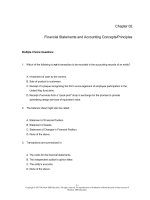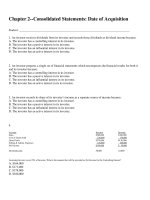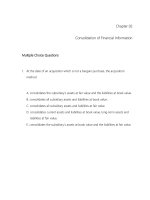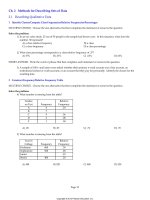Financial statement analysis 11th edition subramanyam test bank
Bạn đang xem bản rút gọn của tài liệu. Xem và tải ngay bản đầy đủ của tài liệu tại đây (553.49 KB, 49 trang )
Chapter 02
Financial Reporting and Analysis
Multiple Choice Questions
1.
Which of the following would require the filing of Form 8-K?
I. Major acquisition
II. Audited financial statements
III. Bankruptcy
IV. Change in management control
A. I and III
B. II and IV
C. I, III, and IV
D. I, II, III, and IV
2.
Which of the following is considered part of GAAP?
A. Statements of Financial Accounting Standards (SFAS)
B. International Accounting Standards (IAS)
C. International Financial Reporting Standards (IFRS)
D. Internal Revenue Services (IRS)
2-1
Copyright © 2014 McGraw-Hill Education. All rights reserved. No reproduction or distribution without the prior written consent of
McGraw-Hill Education.
3.
Which of the following is not considered a monitoring mechanism?
A. The Securities and Exchange Commission (SEC)
B. Top level management
C. The board of director's audit committee
D. The external auditors
4.
Which of the following statements about directors of a company is true?
A. Directors are elected by management of a company.
B. Directors only get paid if the company increases its profitability that year.
C. Directors are shareholders' representatives.
D. All directors of a company are senior managers in that company.
5.
Which of the following statements about accruals is true?
A. Accrual income is less relevant than cash flow.
B. Accruals cannot be manipulated.
C. Accruals are less reliable than cash flows.
D. All accrual accounting adjustments are value irrelevant.
6.
Which of the following statements about cash flows is true?
A. All cash flows are value relevant.
B. Only current cash flows are relevant for valuation.
C. Cash flows are less reliable than accruals.
D. Cash flows can be manipulated.
2-2
Copyright © 2014 McGraw-Hill Education. All rights reserved. No reproduction or distribution without the prior written consent of
McGraw-Hill Education.
7.
Relevance, one of the desirable qualities of accounting information, implies:
A. the capacity of information should be based on five-year average historical data.
B. the capacity of information to affect a decision.
C. the capacity of information should be based on market expectations.
D. that all companies should use same valuation methods such as LIFO and FIFO.
8.
Financial accounting data has some inherent limitations to investors. Which of the following is a
limitation?
I. Not all economic events are easily quantifiable.
II. Many accounting entries rely heavily on estimates.
III. Historical costs do not accurately reflect the true value of firms.
IV. Inflation can distort analysis of accounting data.
A. I, II and III
B. I, III, and IV
C. II, III, and IV
D. I, II, III, and IV
9.
If a company fails to record a material amount of depreciation in a previous year, this is
considered:
A. a change in accounting principle.
B. an unusual item.
C. an accounting error.
D. a change in estimate.
2-3
Copyright © 2014 McGraw-Hill Education. All rights reserved. No reproduction or distribution without the prior written consent of
McGraw-Hill Education.
10. Which of the following is an example of judgments made in the accounting reporting process?
I. Useful life of machinery
II. Allowance for doubtful accounts
III. Obsolescence of assets
IV. Interest payment on bonds
A. I, II, III, and IV
B. I, II, and III
C. II and III
D. I and III
11. Which of the following would affect the comparability of accounting information for a given
company from one accounting period to the next?
I. Change in accounting principles
II. Disposition of segment of business
III. Restructuring expenses
IV. Change in auditors
A. I and II
B. I and III
C. I, II, and III
D. I, III, and IV
2-4
Copyright © 2014 McGraw-Hill Education. All rights reserved. No reproduction or distribution without the prior written consent of
McGraw-Hill Education.
12. Which of the following would affect the comparison of financial statements across two different
firms?
I. Different accounting principles
II. Different sizes of the companies
III. Different reporting periods
IV. Different industries
A. I, III, and IV
B. I and IV
C. I and II
D. I, II, III, and IV
Byfort Company reports the following in its financial statements:
*All sales are on credit.
13. How much did the company collect in cash from customers during 2006?
A. $445,389
B. $454,611
C. $484,289
D. $488,900
2-5
Copyright © 2014 McGraw-Hill Education. All rights reserved. No reproduction or distribution without the prior written consent of
McGraw-Hill Education.
14. How much sales would have been reported by the company in 2006 if Byfort used cash accounting
and not accrual accounting?
A. $445,389
B. $454,611
C. $484,289
D. $488,900
15. 10-K reports are:
A. the quarterly reports to stockholders.
B. quarterly filings made by a company with the SEC.
C. annual filings made by a company with SEC.
D. filings made by a company with SEC when a company changes its auditors.
16. The management of Finner Company believes that "the statement of cash flows is not a very useful
statement" and does not include it with the company's financial statements. As a result the auditor's
opinion should be:
A. qualified.
B. unqualified.
C. clean.
D. disclaimed.
2-6
Copyright © 2014 McGraw-Hill Education. All rights reserved. No reproduction or distribution without the prior written consent of
McGraw-Hill Education.
17. Which of the following statements is incorrect?
A. Under GAAP, statements are prepared using accrual accounting.
B. Under GAAP, all assets are marked to market each accounting period.
C. Under GAAP, it is necessary to make certain estimates.
D. Annual statements submitted to the SEC (10-K) must be prepared using GAAP.
18. When analyzing financial statements, it is important to recognize that accounting distortions can
arise. Accounting distortions are those things that cause deviations in accounting information from
the underlying economics. Which of the following statements is not correct?
A. Accounting distortions can arise as management may deliberately manipulate financial
statements.
B. Accounting distortions arise often through application of (correct) accounting principles.
C. Accounting distortions can affect the quality of earnings.
D. Accounting distortions arise if the stock market is not efficient.
19. Which of the following is a change in an accounting estimate?
I. A change from straight-line depreciation to declining balance method
II. A change in estimated salvage value of depreciable asset
III. A change in estimated useful life of an asset
IV. Recording depreciation for the first time on machinery purchased five years ago
A. I, II, III, and IV
B. II, III, and IV
C. I, III, and IV
D. II and III
2-7
Copyright © 2014 McGraw-Hill Education. All rights reserved. No reproduction or distribution without the prior written consent of
McGraw-Hill Education.
20. Which of the following is a change in accounting principle?
I. A change from LIFO to FIFO
II. A change in estimated salvage value of depreciable asset
III. A change from an accelerated depreciation method to straight-line depreciation
IV. Recording depreciation for the first time on machinery purchased five years ago
A. I, II, III, and IV
B. I, II, and III
C. I, III, and IV
D. I and III
21. Which of the following is not a source of industry information?
A. Cash budget
B. Standard and Poor's
C. Trade journals
D. Value line
22. Which of the following information would not be filed with the SEC by a publicly traded company?
A. 10-K report
B. Prospectus
C. Proxy statement
D. Tax return
2-8
Copyright © 2014 McGraw-Hill Education. All rights reserved. No reproduction or distribution without the prior written consent of
McGraw-Hill Education.
23. Accounting standards are:
A. the result of a political process among groups with diverse interests.
B. presentation standards mandated by the Securities and Exchange Commission.
C. the state-of-the-art presentation of the science of accounting.
D. standards measuring the quality of safeguarding assets.
24. The matching principle requires that:
A. revenues earned and expenses incurred in generating those revenues should be reported in the
same income statement.
B. non-operating gains and losses should be netted against each other.
C. a proportion of each dollar collected will be assumed to be a recovery of cost.
D. assets will be matched to the liabilities incurred to purchase them.
25. Which of the following is required to be filed with the SEC, if a company changes its auditors?
A. 10-K
B. 10-Q
C. 8-K
D. S-1
26. The primary responsibility for fair and accurate financial reporting rests with the:
A. shareholders.
B. SEC.
C. management.
D. auditors.
2-9
Copyright © 2014 McGraw-Hill Education. All rights reserved. No reproduction or distribution without the prior written consent of
McGraw-Hill Education.
27. Which of the following is incorrect? When using the 10-Q, the analyst should be aware that the
usefulness of the quarterly financial statements might be affected by:
A. seasonality.
B. adjustments made in the final quarter of the year.
C. the use of cash accounting.
D. the increased use of estimates.
28. Voluntary disclosure by managers is becoming an increasingly important source of information.
Which of the following is least likely to be a reason for this increased disclosure?
A. Protection under Safe Harbor Rules
B. To manage investors' expectations
C. To communicate information to investors
D. To respond to increased demands by labor unions
29. ______ are secondary qualities of accounting information that make it useful for decision making.
A. Consistency and comparability
B. Relevance and reliability
C. Materiality and comparability
D. Full disclosure and relevance
2-10
Copyright © 2014 McGraw-Hill Education. All rights reserved. No reproduction or distribution without the prior written consent of
McGraw-Hill Education.
30. Economic income measures change in:
A. asset value.
B. liability value.
C. shareholder value.
D. net cash flows.
31. Which one of the following is not an example of a red flag to one should be aware of when
evaluating earnings quality?
A. Qualified audit report
B. Net income this year is higher than net income from last year
C. Reported earnings consistently higher than operating cash flows
D. Frequent or unexplained changes in accounting policies
32. Economic income includes:
A. recurring components only.
B. nonrecurring components only.
C. both recurring and nonrecurring components.
D. neither recurring nor nonrecurring components.
33. For a going concern, company value can be expressed by:
A. dividing permanent income by the cost of capital.
B. multiplying permanent income by the cost of capital.
C. dividing permanent income by the market value per share.
D. multiplying permanent income by the market value per share.
2-11
Copyright © 2014 McGraw-Hill Education. All rights reserved. No reproduction or distribution without the prior written consent of
McGraw-Hill Education.
34. Accounting income consists of all the following components except:
A. permanent component.
B. transitory component.
C. value irrelevant component.
D. realized component.
35. To determine a company's sustainable earning power, an analyst needs to first determine the
recurring component of the current period's accounting income by excluding nonrecurring
components of accounting income. Such adjusted earnings are often referred to as:
A. core earnings.
B. transitory earnings.
C. basic earnings.
D. operating earnings.
36. SFAS 157 defines fair value as the:
A. entry price.
B. exchange price.
C. net asset value.
D. real value.
2-12
Copyright © 2014 McGraw-Hill Education. All rights reserved. No reproduction or distribution without the prior written consent of
McGraw-Hill Education.
37. SFAS prescribes that information about the level of inputs used for determining fair values must be
reported in the:
A. balance sheet.
B. director's letter.
C. footnotes.
D. MD&A.
38. All of the following are basic approaches to valuation except:
A. market approach.
B. book value approach.
C. income approach.
D. cost approach.
True / False Questions
39. GAAP stands for General American Accounting Principles, and must be adhered to by publicly
traded companies when preparing their financial statements.
True
False
40. FASB stands for Financial Accounting Service Bureau, and is a sub-division of the Securities and
Exchange Commission (SEC).
True
False
2-13
Copyright © 2014 McGraw-Hill Education. All rights reserved. No reproduction or distribution without the prior written consent of
McGraw-Hill Education.
41. Under GAAP accounting, a company has the choice of using cash or accrual accounting in
preparing its financial statements.
True
False
42. Under cash accounting, a company must recognize revenues in financial statements when the
revenues are earned or realized.
True
False
43. Under accrual accounting, a company will recognize expenses as they are paid.
True
False
44. Accrual income is a better predictor of future cash flows than current cash flows.
True
False
45. External auditors provide "reasonable", as opposed to "absolute" assurance that the financial
statements provide no material misstatement.
True
False
46. Net income is usually higher than free cash flows.
True
False
47. By using earnings management, managers always try to increase income.
True
False
2-14
Copyright © 2014 McGraw-Hill Education. All rights reserved. No reproduction or distribution without the prior written consent of
McGraw-Hill Education.
48. Income smoothing is a form of earnings management.
True
False
49. Income shifting is not one of the earnings management mechanics.
True
False
50. The development of the financial statements is management's responsibility, and the auditor is not
concerned with the process of development.
True
False
51. Accounting information is "material" if its omission would cause a reasonable person to make a
different decision if the information was included.
True
False
52. Accounting distortions arise from the nature of accrual accounting.
True
False
53. Primary responsibility for fair and accurate financial statements rests with the auditors.
True
False
54. Audits are designed and implemented with the objective of detecting fraud.
True
False
2-15
Copyright © 2014 McGraw-Hill Education. All rights reserved. No reproduction or distribution without the prior written consent of
McGraw-Hill Education.
55. Accounting standards issued by the SEC are applicable to all US companies being audited.
True
False
56. The "big bath" strategy is often used in conjunction with an income-increasing strategy for other
years.
True
False
57. Accounting standards are set by the American Institute of Certified Public Accountants (AICPA).
True
False
58. The Securities and Exchange Commission (SEC) has the power to issue accounting standards, but
generally defers this responsibility to the Financial Accounting Standards Board (FASB).
True
False
59. Accrual accounting overcomes both the timing and the matching problems that are inherent in
cash accounting.
True
False
60. FASB has recognized the conceptual superiority of the historical value concept and has, in principle,
decided to eventually move to a model where all asset and liability values are recorded at fair
value.
True
False
61. Accounting or reported income is same as economic income.
True
False
2-16
Copyright © 2014 McGraw-Hill Education. All rights reserved. No reproduction or distribution without the prior written consent of
McGraw-Hill Education.
62. Operating income is often referred to as net operating profit before tax.
True
False
63. Accounting income attempts to capture elements of both permanent income and economic
income, but with measurement error.
True
False
64. Operating earnings includes all revenue and expense components that pertain to the company's
operating business, regardless of whether they are recurring or nonrecurring.
True
False
65. Under the fair value model, income is determined by matching costs to recognized revenues, which
have to be realized and earned.
True
False
66. The fair value of an asset is the hypothetical price at which a business can sell the asset (exit price).
True
False
Essay Questions
2-17
Copyright © 2014 McGraw-Hill Education. All rights reserved. No reproduction or distribution without the prior written consent of
McGraw-Hill Education.
67. Motivation to Manipulate Financial Results
There are many ways in which the management of a company can manage the reported earnings.
Give three reasons why management may want to manage earnings being sure to explain your
answer in full.
2-18
Copyright © 2014 McGraw-Hill Education. All rights reserved. No reproduction or distribution without the prior written consent of
McGraw-Hill Education.
68. Earnings Management
Earnings management can be defined as the "purposeful intervention by management in the
earnings process, usually to satisfy selfish objectives" (Schipper, 1989).
Earnings management techniques can be separated into those that are "cosmetic" (without cash
flow consequences) and those that are "real" (with cash flow consequences).
The management of a company wishes to increase earnings this period.
List three "cosmetic" and three "real" techniques that can be used to achieve this objective and
explain why they will achieve the objective.
2-19
Copyright © 2014 McGraw-Hill Education. All rights reserved. No reproduction or distribution without the prior written consent of
McGraw-Hill Education.
69. Identifying red flags
One step in assessing the quality of earnings is to look for red flags. An example of a red flag is a
significant increase in accounts receivable without commensurate growth in sales (that is, accounts
receivable turnover decreases). List five other red flags an astute analyst might look for. Also,
provide the reason for it being a red flag, and identify where the analyst might find this
information.
70. Discretionary Expenditures
Discretionary expenditures are outlays that management can vary across periods to conserve
resources and/or manage earnings. Give three examples and explain their potential impact on
earnings quality when analyzing a company.
2-20
Copyright © 2014 McGraw-Hill Education. All rights reserved. No reproduction or distribution without the prior written consent of
McGraw-Hill Education.
71. Balance Sheet Analysis of Earnings Quality
The relevance of reported asset values is linked (with few exceptions like cash, held-to-maturity
investments, and land) with their ultimate recognition as reported expenses. Provisions and liability
values on the balance sheet may also affect earnings quality. For each of the following give an
example and explain its impact upon cumulative earnings.
a. An overstated asset
b. An understated asset
c. An overstated liability or provision
d. An understated liability or provision
2-21
Copyright © 2014 McGraw-Hill Education. All rights reserved. No reproduction or distribution without the prior written consent of
McGraw-Hill Education.
72. Fair Value Accounting
ABC Co. starts its business raising $110,000 in cash; $60,000 from issuing equity and $50,000 from
issuing 6% bonds at par. ABC used the whole amount of cash to buy a building, which it rents out
for $10,000 per year. Given below is the opening balance sheet of ABC Co. for the first year of
operations.
At the end of Year 1, the building is valued at $150,000. Also, the market value of bonds has fallen
to $49,000. Assume the useful life of the building is 30 years, and its salvage value is $50,000 at the
end of that period. The rental income is received on the last day of the year. Interest on bonds is
also paid on this day.
Prepare the year-end balance sheet and income statement of ABC Co. based on Fair value.
Compare the historical and fair values at year-end.
2-22
Copyright © 2014 McGraw-Hill Education. All rights reserved. No reproduction or distribution without the prior written consent of
McGraw-Hill Education.
Chapter 02 Financial Reporting and Analysis Answer Key
Multiple Choice Questions
1.
Which of the following would require the filing of Form 8-K?
I. Major acquisition
II. Audited financial statements
III. Bankruptcy
IV. Change in management control
A. I and III
B. II and IV
C. I, III, and IV
D. I, II, III, and IV
2.
Which of the following is considered part of GAAP?
A. Statements of Financial Accounting Standards (SFAS)
B. International Accounting Standards (IAS)
C. International Financial Reporting Standards (IFRS)
D. Internal Revenue Services (IRS)
2-23
Copyright © 2014 McGraw-Hill Education. All rights reserved. No reproduction or distribution without the prior written consent of
McGraw-Hill Education.
3.
Which of the following is not considered a monitoring mechanism?
A. The Securities and Exchange Commission (SEC)
B. Top level management
C. The board of director's audit committee
D. The external auditors
4.
Which of the following statements about directors of a company is true?
A. Directors are elected by management of a company.
B. Directors only get paid if the company increases its profitability that year.
C. Directors are shareholders' representatives.
D. All directors of a company are senior managers in that company.
5.
Which of the following statements about accruals is true?
A. Accrual income is less relevant than cash flow.
B. Accruals cannot be manipulated.
C. Accruals are less reliable than cash flows.
D. All accrual accounting adjustments are value irrelevant.
6.
Which of the following statements about cash flows is true?
A. All cash flows are value relevant.
B. Only current cash flows are relevant for valuation.
C. Cash flows are less reliable than accruals.
D. Cash flows can be manipulated.
2-24
Copyright © 2014 McGraw-Hill Education. All rights reserved. No reproduction or distribution without the prior written consent of
McGraw-Hill Education.
7.
Relevance, one of the desirable qualities of accounting information, implies:
A. the capacity of information should be based on five-year average historical data.
B. the capacity of information to affect a decision.
C. the capacity of information should be based on market expectations.
D. that all companies should use same valuation methods such as LIFO and FIFO.
8.
Financial accounting data has some inherent limitations to investors. Which of the following is a
limitation?
I. Not all economic events are easily quantifiable.
II. Many accounting entries rely heavily on estimates.
III. Historical costs do not accurately reflect the true value of firms.
IV. Inflation can distort analysis of accounting data.
A. I, II and III
B. I, III, and IV
C. II, III, and IV
D. I, II, III, and IV
9.
If a company fails to record a material amount of depreciation in a previous year, this is
considered:
A. a change in accounting principle.
B. an unusual item.
C. an accounting error.
D. a change in estimate.
2-25
Copyright © 2014 McGraw-Hill Education. All rights reserved. No reproduction or distribution without the prior written consent of
McGraw-Hill Education.









